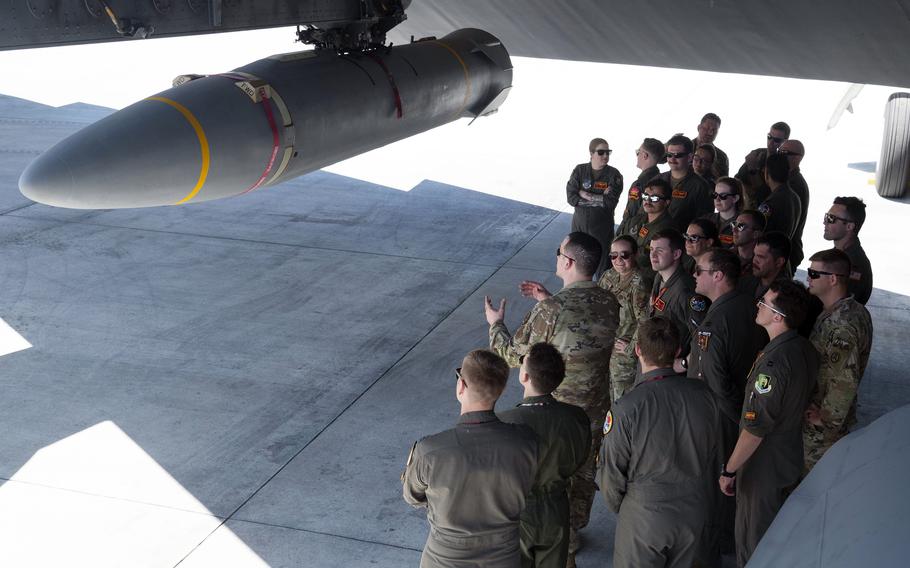
B-52 Stratofortress bomber crews take part in hypersonic weapon familiarization training at Andersen Air Force Base, Guam, on Feb. 27, 2024. (Pedro Tenorio/U.S. Air Force)
Airmen on Guam trained last week on a hypersonic weapon the Air Force has kept under wraps for nearly a year.
Photographs of airmen checking out what appears to be an AGM-183 Air-launched Rapid Response Weapon were released on Andersen Air Force Base’s website Feb. 29. It was mounted beneath a B-52H Stratofortress bomber.
The AGM-183 is a conventional, rocket-powered hypersonic gliding missile with a warhead of “kinetic energy” projectiles rather than explosives, according to a fiscal 2021 Air Force report.
“The Air-launched Rapid Response Weapon (ARRW) program combines critical high-speed flight technologies and accelerates the weaponization of air-to-ground hypersonic strike capabilities for the U.S. Air Force,” manufacturer Lockheed Martin states on its website.
Andersen is the only spot in the Indo-Pacific where the Air Force is conducting the training, 1st Lt. Ariana Wilkinson, spokeswoman for Andersen’s 36th Wing, said by email Monday.
Similar training happened Sept. 28 at Edwards Air Force Base, Calif. It included B-52, B-1 Lancer, B-2 Spirit and F-15E Strike Eagle crews from across Global Strike Command and Air Combat Command, according to the Air Force.
Guam’s training involved crews from the 23rd Expeditionary Bomb Squadron and the 49th Test and Evaluation Squadron, Wilkinson said. The 23rd is based at Minot Air Force Base, S.D.; the 49th is from Barksdale Air Force Base, La.
Plugging back in
The training comes nearly a year after the service appeared to pull the plug on the hypersonic cruise missile.
The Air Force asked $150.3 million for research and to test the weapon, Air Force assistant secretary Andrew Hunter told the House subcommittee on tactical and land forces March 29.
“While the Air Force does not currently intend to pursue follow-on procurement” of the AGM-183 once it develops a prototype, “there is inherent benefit to completing” the test flights “to garner the learning and test data that will help inform future hypersonic programs and, potential leave behind capability support,” according to a record of that testimony on the Armed Services Committee website.
On Guam, airmen trained on hypersonic fundamentals and discussed hypersonic operations to increase readiness and prepare for the weapons, including the Hypersonic Attack Cruise Missile, Air-launched Rapid Response Weapon and other programs under development, according to a news release that accompanied the photos.
“The Air Force will continue to invest in researching, developing, testing, producing, and fielding cost-effective weapons,” the release said. “These weapons are a mix of stand-off, stand-in, hypersonic, and subsonic precision guided munitions.”
Both China and Russia have conducted test launches and fielded their versions of the new weapons, which can travel five times the speed of sound and maneuver in flight like a cruise missile, making them harder to detect and shoot down.
Hypersonic ‘scandal’
The U.S. military is scrambling to defend against hypersonics, retired Marine Col. Grant Newsham, a senior researcher with the Japan Forum for Strategic Studies in Tokyo, said Monday.
He described the U.S. lag in hypersonic weapons as a “scandal.”
“The most senior U.S. leaders in the Pacific and elsewhere were warned at least in the mid-2010s of [Chinese] hypersonic development and the specific damage they could cause to U.S. warfighting capabilities in the Asia-Pacific and beyond,” he said in an email to Stars and Stripes.
Once operational, hypersonic missiles will give U.S. forces weapons that are difficult to intercept and that could be used to strike Chinese targets in a contingency, Newsham said.
“This increases the chance of a successful strike — and that’s obviously important — if not essential,” he said. “You want to hit what you’re aiming at and without the enemy being able to intercept or disrupt your projectile. Hypersonic weapons can be particularly useful against high-value targets — such as command and control nodes — and also key infrastructure.”
In the event of a Chinese attack on Taiwan, hypersonic weapons could strike targets on the Chinese mainland, such as command and control centers, ports and airfields, power plants and logistics hubs, Newsham said.
“That would hurt [China’s] ability to conduct an offensive against Taiwan, or perhaps allow U.S. forces to respond in kind if [China] attacks U.S. or allied facilities in Japan, Guam, or elsewhere,” he said.